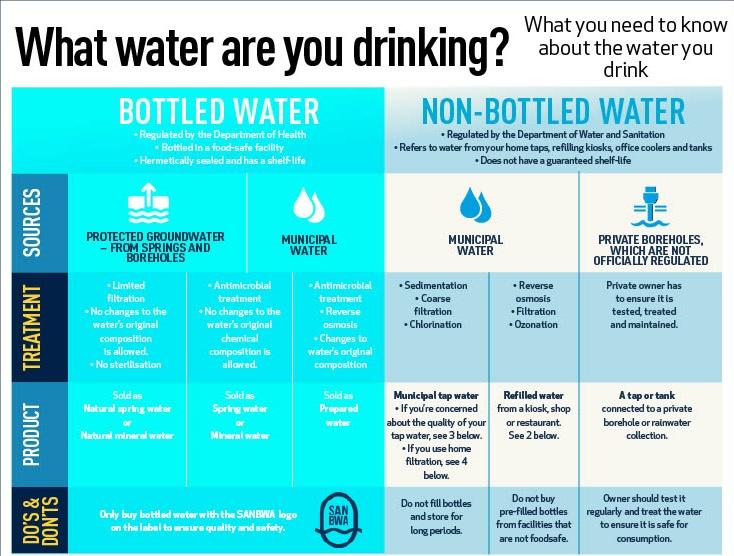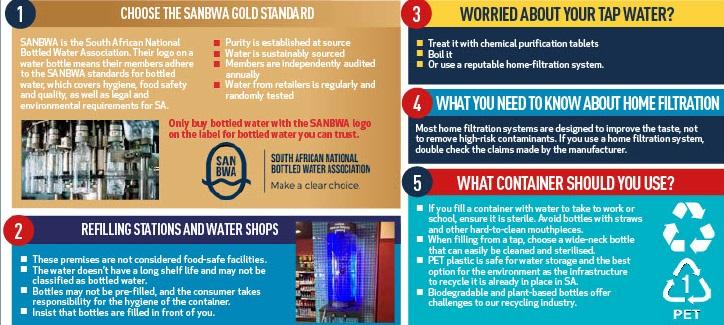Three separate audit reports have shown that over 50% of South Africa’s municipal water systems are not treated to safe drinking standards or, in the worst-case scenarios, are polluted by sewage and other effluents. In both instances, they are unsafe for human consumption.
Critically, water experts also warn that a Blue Drop score of less than 80% identifies a system that may have unsafe water. This is because the Blue Drop programme consolidates various key performance indicators to arrive at an overall score. As a result, areas with Blue Drop status – but a score of less than 80% – may include reservoirs or systems that are red and unsafe for consumption.
This means that holidaymakers – whether they stay in campsites, rented accommodation, resorts, hotels or even family homes on the country’s coast and ‘platteland’ – need to take extra care to ensure the water they drink does not ruin their December fun.
“This water crisis must not discourage us from hydrating,” urges South Africa National Bottled Water Association CEO, Charlotte Metcalf. “December is the height of summer and South Africans relish spending time outside swimming, hiking, playing sports, gathering around the braai or simply soaking up the sun. The danger of becoming dehydrated is high, and drinking water is the go-to option for rehydrating.”
Seemingly, the easiest option for avoiding contaminated water would be to purchase and consume water from an alternative supply, but Metcalf provides some insight and advice.
First, she suggests investigating if the municipal water supply system is safe:
- Visit www.dws.gov.za, access the IRIS app under ‘Green Drop reports/Blue Drop progress’ and enter the suburb name to search for its status.
- If the supply is not microbiologically safe, use an alternative safe supply of water or boil the water before consumption.
- If the water is chemically unsafe, use an alternative safe supply of water or suitable filtration.
If your water supply is unsafe, Metcalf suggests the following when it comes to alternative supplies:
- Only buying bottled water with the SANBWA logo on the label to ensure quality and safety.
South Africans’ distrust of municipal water quality has attracted many new entrants into the bottled market, but not all comply with the strict legislation that regulates all enterprises packaging water for sale to the public. Fly-by-night operators think nothing of bottling waters from unsuitable sources under unsanitary conditions and into packaging that might not even be sterile. - Not filling bottles from home filtration systems, tanks or re-filling stations and storing them for long periods because these waters do not have a guaranteed shelf-life.
- Not buying pre-filled bottles from re-fill facilities.
Shoppers must insist that the bottles are filled in front of them into the container they brought and not simply swap their empty container for a full one. These facilities seldom adhere to packaged water legislation and therefore are not legally allowed to market and sell their pre-filled waters as bottled water. - Avoiding waters offered in ready-filled bottles by restaurants
Unless the filters (or the membranes if using reverse osmosis technology to filter the water) used in restaurant countertop systems are fit for purpose, inspected, maintained, and changed regularly, they will contaminate the water they dispense with unhealthy bacteria and fungi and not remove critical contamination. In addition, the hoses through which the water runs, the containers that are filled, and the lids that seal these containers are hotbeds for bacterial growth if they are not cleaned and sanitised thoroughly. Insist on being served water in a glass or jug or bottled water carrying the SANBWA logo. - Testing and treating borehole, tank and other environmental sources of water regularly to ensure it is safe for consumption.
- Double-checking the claims made by manufacturers of home filtration systems as most of these are designed to improve the taste, not to remove high-risk contaminants. These also need potable water at the inlet and cannot handle heavily contaminated water.
“The only surefire way to ensure the water you are purchasing is safe is to look for the SANBWA logo on the bottle,” she says.
“This offers the consumer peace of mind that the product is from a source that has been vigorously checked for the absence of contamination and pollution, that the bottling facility is hygienic and operated according to good manufacturing practices, and that the necessary procedures are in place to ensure the quality of the product.”
SANBWA members’ brands include AquaBella, aQuellé, Bené, Bonaqua, Designer Water, Fontein, La Vie de Luc, Nestlé Pure Life, Straven , Thirsti and Valpré.

